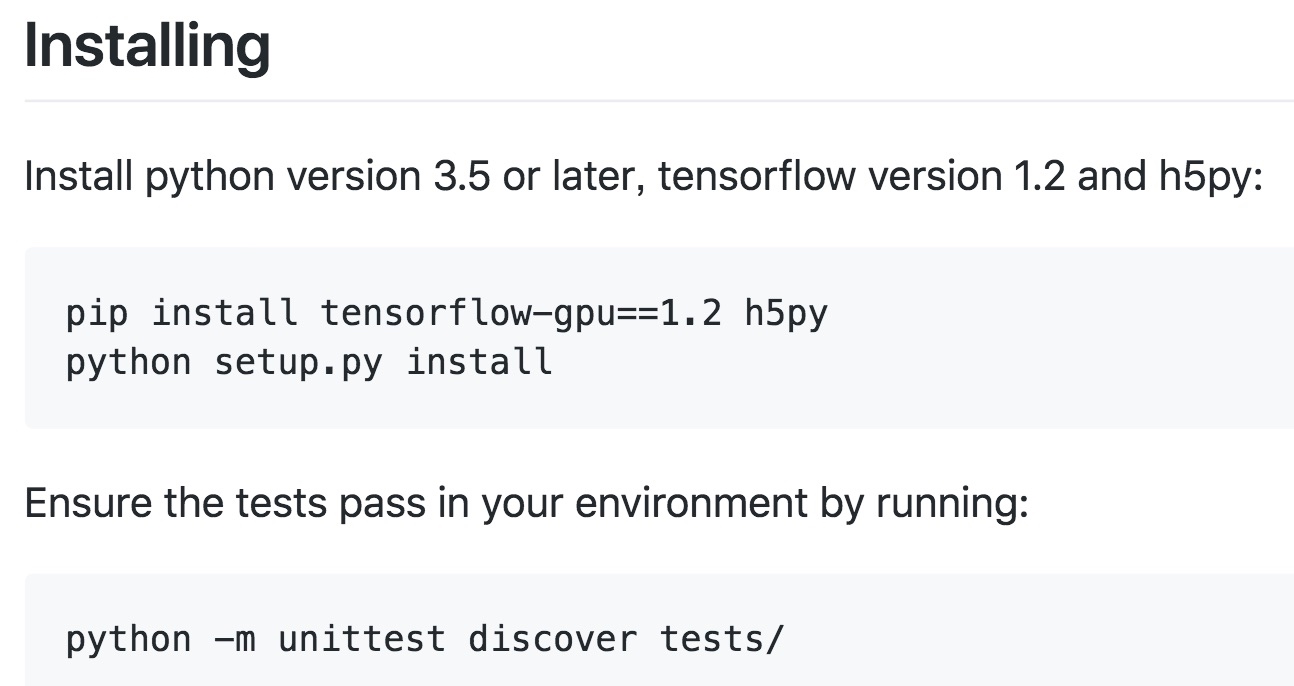如何將ELMo詞向量用於中文
10.10更新:ELMo已經由哈工大組用PyTorch重寫了,並且提供了中文的預訓練好的language model,可以直接使用。
ELMo於今年二月由AllenNLP提出,與word2vec或GloVe不同的是其動態詞向量的思想,其本質即通過訓練language model,對於一句話進入到language model獲得不同的詞向量。根據實驗可得,使用了Elmo詞向量之後,許多NLP任務都有了大幅的提高。
論文:Deep contextualized word representations
AllenNLP一共release了兩份ELMo的程式碼,一份是Pytorch版本的,另一份是Tensorflow版本的。Pytorch版本的只開放了使用預訓練好的詞向量的介面,但沒有給出自己訓練的介面,因此無法使用到中文語料中。Tensorflow版本有提供訓練的程式碼,因此本文記錄如何將ELMo用於中文語料中,但本文只記錄使用到的部分,而不會分析全部的程式碼。
需求:
使用預訓練好的詞向量作為句子表示直接傳入到RNN中(也就是不使用程式碼中預設的先過CNN),在訓練完後,將模型儲存,在需要用的時候load進來,對於一個特定的句子,首先將其轉換成預訓練的詞向量,傳入language model之後最終得到ELMo詞向量。
準備工作:
- 將中文語料分詞
- 訓練好GloVe詞向量或者word2vec
- 下載bilm-tf程式碼
- 生成詞表 vocab_file (訓練的時候要用到)
- optional:閱讀Readme
- optional:通讀bilm-tf的程式碼,對程式碼結構有一定的認識
思路:
- 將預訓練的詞向量讀入
- 修改bilm-tf程式碼
- option部分
- 新增給embedding weight賦初值
- 新增儲存embedding weight的程式碼
- 開始訓練,獲得checkpoint和option檔案
- 執行指令碼,獲得language model的weight檔案
- 將embedding weight儲存為hdf5檔案形式
- 執行指令碼,將語料轉化成ELMo embedding。
訓練GloVe或word2vec
可參見我以前的部落格或者網上的教程。
注意到,如果要用gensim匯入GloVe訓好的詞向量,需要在開頭新增num_word embedding_dim。 如:
獲得vocab詞表檔案
注意到,詞表檔案的開頭必須要有<S> </S> <UNK>,且大小寫敏感。並且應當按照單詞的詞頻降序排列。可以通過手動新增這三個特殊符號。
如:
程式碼:
model=gensim.models.KeyedVectors.load_word2vec_format(
fname='/home/zhlin/GloVe/vectors.txt',binary=False
)
words=model.vocab
with open('vocab.txt','w') as f:
f.write('<S>')
f.write('\n')
f.write('</S>')
f.write('\n')
f.write('<UNK>')
f.write('\n') # bilm-tf 要求vocab有這三個符號,並且在最前面
for word in words:
f.write(word)
f.write('\n')修改bilm-tf程式碼
注意到,在使用該程式碼之前,需要安裝好相應的環境。
如果使用的是conda作為預設的Python直譯器,強烈建議使用conda安裝,否則可能會出現一些莫名的錯誤
conda install tensorflow-gpu=1.4
conda install h5py
python setup.py install #應在bilm-tf的資料夾下執行該指令
然後再執行測試程式碼,通過說明安裝成功。
修改train_elmo.py
bin資料夾下的train_elmo.py是程式的入口。
主要修改的地方:
- load_vocab的第二個引數應該改為None
- n_gpus CUDA_VISIBLE_DEVICES 根據自己需求改
- n_train_tokens 可改可不改,影響的是輸出資訊。要檢視自己語料的行數,可以通過
wc -l corpus.txt檢視。 - option的修改,將char_cnn部分都註釋掉,其他根據自己需求修改
修改LanguageModel類
由於我需要傳入預訓練好的GloVe embedding,那麼還需要修改embedding部分,這部分在bilm資料夾下的training.py,進入到LanguageModel類中_build_word_embeddings函式中。注意到,由於前三個是<S> </S> <UNK>,而這三個字元在GloVe裡面是沒有的,因此這三個字元的embedding應當在訓練的時候逐漸學習到,而正因此 embedding_weights的trainable應當設為True
如:
修改train函式
新增程式碼,使得在train函式的最後儲存embedding檔案。
訓練並獲得weights檔案
訓練需要語料檔案corpus.txt,詞表檔案vocab.txt。
訓練
cd到bilm-tf資料夾下,執行
export CUDA_VISIBLE_DEVICES=4
nohup python -u bin/train_elmo.py \
--train_prefix='/home/zhlin/bilm-tf/corpus.txt' \
--vocab_file /home/zhlin/bilm-tf/glove_embedding_vocab8.10/vocab.txt \
--save_dir /home/zhlin/bilm-tf/try >bilm_out.txt 2>&1 &
根據實際情況設定不同的值和路徑。
PS:執行過程中可能會有warning:
‘list’ object has no attribute ‘name’
WARNING:tensorflow:Error encountered when serializing lstm_output_embeddings.
Type is unsupported, or the types of the items don’t match field type in CollectionDef.
應該不用擔心,還是能夠繼續執行的,後面也不受影響。
在等待了相當長的時間後,在save_dir資料夾內生成了幾個檔案,其中checkpoint和options是關鍵,checkpoint能夠進一步生成language model的weights檔案,而options記錄language model的引數。
獲得language model的weights
接下來執行bin/dump_weights.py將checkpoint轉換成hdf5檔案。
nohup python -u /home/zhlin/bilm-tf/bin/dump_weights.py \
--save_dir /home/zhlin/bilm-tf/try \
--outfile /home/zhlin/bilm-tf/try/weights.hdf5 >outfile.txt 2>&1 &其中save_dir是checkpoint和option檔案儲存的地址。
接下來等待程式執行:
將語料轉化成ELMo embedding
由於我們有了vocab_file、與vocab_file一一對應的embedding h5py檔案、以及language model的weights.hdf5和options.json。
接下來參考usage_token.py將一句話轉化成ELMo embedding。
參考程式碼:
import tensorflow as tf
import os
from bilm import TokenBatcher, BidirectionalLanguageModel, weight_layers, \
dump_token_embeddings
# Our small dataset.
raw_context = [
'這 是 測試 .',
'好的 .'
]
tokenized_context = [sentence.split() for sentence in raw_context]
tokenized_question = [
['這', '是', '什麼'],
]
vocab_file='/home/zhlin/bilm-tf/glove_embedding_vocab8.10/vocab.txt'
options_file='/home/zhlin/bilm-tf/try/options.json'
weight_file='/home/zhlin/bilm-tf/try/weights.hdf5'
token_embedding_file='/home/zhlin/bilm-tf/glove_embedding_vocab8.10/vocab_embedding.hdf5'
## Now we can do inference.
# Create a TokenBatcher to map text to token ids.
batcher = TokenBatcher(vocab_file)
# Input placeholders to the biLM.
context_token_ids = tf.placeholder('int32', shape=(None, None))
question_token_ids = tf.placeholder('int32', shape=(None, None))
# Build the biLM graph.
bilm = BidirectionalLanguageModel(
options_file,
weight_file,
use_character_inputs=False,
embedding_weight_file=token_embedding_file
)
# Get ops to compute the LM embeddings.
context_embeddings_op = bilm(context_token_ids)
question_embeddings_op = bilm(question_token_ids)
elmo_context_input = weight_layers('input', context_embeddings_op, l2_coef=0.0)
with tf.variable_scope('', reuse=True):
# the reuse=True scope reuses weights from the context for the question
elmo_question_input = weight_layers(
'input', question_embeddings_op, l2_coef=0.0
)
elmo_context_output = weight_layers(
'output', context_embeddings_op, l2_coef=0.0
)
with tf.variable_scope('', reuse=True):
# the reuse=True scope reuses weights from the context for the question
elmo_question_output = weight_layers(
'output', question_embeddings_op, l2_coef=0.0
)
with tf.Session() as sess:
# It is necessary to initialize variables once before running inference.
sess.run(tf.global_variables_initializer())
# Create batches of data.
context_ids = batcher.batch_sentences(tokenized_context)
question_ids = batcher.batch_sentences(tokenized_question)
# Compute ELMo representations (here for the input only, for simplicity).
elmo_context_input_, elmo_question_input_ = sess.run(
[elmo_context_input['weighted_op'], elmo_question_input['weighted_op']],
feed_dict={context_token_ids: context_ids,
question_token_ids: question_ids}
)
print(elmo_context_input_,elmo_context_input_)
可以修改程式碼以適應自己的需求。










